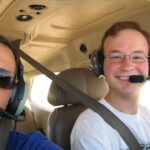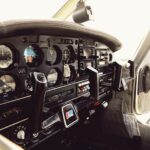
When you’re flying beyond the reach of well-trodden airways, the right navigation skills are your lifeline. Backcountry flying isn’t just about the thrill and the freedom—it’s about being prepared. And preparation starts with knowing your tools and techniques inside out.
Let’s gear up and get ready to chart your course through the remote skies. Remember, in the backcountry, your skills are as crucial as your aircraft.
Charting Your Path: Fundamental Tools and Techniques for Back Country Navigation
Whether you’re skimming over mountain ridges or threading through valleys, navigation in the backcountry demands precision and expertise. It’s about combining the wisdom of old-school techniques with the efficiency of modern technology. The key is to blend these approaches seamlessly to ensure you always have a bead on your location.
Understanding the lay of the land and the sky above is just the beginning. You’ll need to be comfortable reading topographic features from a chart and interpreting them in the real world. It’s about making the map in your hand reflect the terrain beneath your wings.
And let’s not forget the weather. Backcountry areas are often subject to rapid changes in weather conditions. It’s crucial to know how to read the signs, both in the sky and on your instruments, to avoid getting caught off-guard.
Essential Navigation Gear for the Backcountry
Your navigation gear is as important as your aircraft’s engine. Without it, you’re just a pilot flying blind. Here’s what you need to have in your cockpit:
- Aeronautical charts: These are your road maps in the sky, showing you everything from terrain elevations to airspace boundaries.
- GPS: A reliable GPS can be a game-changer, but never rely on it solely. Always have a backup plan.
- Compass: Sometimes, the old ways are the best ways. A compass doesn’t need batteries or a signal.
- Emergency Locator Transmitter (ELT): In case things go south, this will be your voice when you can’t use yours.
- Headlamp with red light: For reading your charts and instruments without ruining your night vision.
- Backup power source: Whether it’s extra batteries or a portable charger, always have a way to power your gear.
These tools are your ticket to a safe flight. Treat them well, and they’ll do the same for you.
Tips for Effective Pre-flight Planning
Every successful backcountry flight starts on the ground. Pre-flight planning is where you set the stage for a safe and enjoyable trip. Here’s what you should do before taking off:
Check the weather, not just for your departure and destination, but for the entire route. Weather can change quickly and dramatically in remote areas.
Study your route in detail. Know the terrain, the airspace, and potential obstacles. Mark out landmarks and emergency landing spots.
Inform someone about your flight plan. Let them know where you’re going and when you expect to return. It’s a simple step that can make all the difference in an emergency.
Weight and balance calculations are critical, especially when flying in areas where you might need to maneuver around obstacles or make steep climbs.
Key Takeaways
Here’s what you need to remember when navigating the backcountry:
- Combine traditional navigation skills with modern technology for the best results.
- Always have the essential gear on board, and know how to use it.
- Thorough pre-flight planning is non-negotiable for a safe journey.
- Stay informed about the weather and be ready to adjust your plans accordingly.
- Never fly without letting someone know your flight plan—it’s a basic but vital safety measure.
Mastering Map and Compass: The Pilots’ Guide
Reading a map and using a compass may seem like skills from a bygone era, but they’re as relevant as ever in the backcountry. Let’s break down how to master these essential tools:
First, get your hands on the most current aeronautical chart for your area. These charts are packed with information, from elevation contours to navigational aids. Spend time with your chart before the flight, familiarizing yourself with the symbols and terrain.
Next, your compass. It’s not just about knowing which way is north. It’s about understanding how to use that information to find your way. Practice taking bearings on the ground, and learn how to translate them into the air.
Here’s what you should be able to do with a map and compass:
- Orient the map to match the terrain around you.
- Identify your current location using landmarks and features.
- Plot a course by taking bearings and transferring them to your map.
- Adjust for magnetic declination to ensure your compass readings are accurate.
- Use your compass to maintain a heading, even when landmarks are scarce.
These skills are your foundation. With them, you’ll be able to navigate confidently, even when technology lets you down.
Interpreting Aeronautical Charts
Aeronautical charts are your silent co-pilots. They speak a language of symbols and lines that tell a story of what’s above and below. Learning to interpret these charts is like learning to read a new language. Here’s how you do it:
First, identify the different types of airspace on the chart. Each type has its own rules and requirements. Next, look for symbols that represent airports, navigational aids, and landmarks. These are the signposts in the sky that guide your way.
Pay attention to the contour lines as well. They show changes in terrain elevation, which is critical when you’re flying low. Spotting a mountain pass or a valley on the chart can help you navigate through tricky areas.
Remember, the more time you spend with your chart, the more it will reveal to you. It’s a treasure map, and the treasure is a safe and successful flight.
Navigating with a Compass in Featureless Terrain
When you’re flying over a landscape with few landmarks, a compass is your best friend. Here’s the thing about featureless terrain: it can be disorienting. But a compass gives you a point of reference that never changes—magnetic north.
Keep your compass calibrated and understand how to correct for magnetic variation. When you’re in the air, trust your compass and your heading. Even when everything looks the same below, your compass tells you you’re on the right track.
Combine compass readings with time and speed calculations to estimate your position. This method, called dead reckoning, is an old-school technique that still holds up today.
GPS Integration: Modern Tools in Remote Skies
Now, let’s talk about GPS. This satellite-based system has transformed navigation, making it easier and more accurate. In the backcountry, a GPS can be a beacon of hope in a sea of uncertainty.
With a GPS, you can pinpoint your exact location in seconds. You can track your route, find waypoints, and even get real-time weather updates. It’s a powerful tool that can make backcountry flying safer and more enjoyable.
Advantages of GPS-aided Navigation
Here’s why GPS is a game-changer in the skies:
- Accuracy: GPS provides precise location data, often within a few meters.
- Convenience: With GPS, you have all your navigation information in one place.
- Efficiency: GPS can help you find the most direct routes, saving time and fuel.
- Confidence: Knowing your exact position can be reassuring in unfamiliar territory.
- Emergency support: In case of an emergency, GPS can guide rescuers to your location quickly.
But while GPS is a marvel of modern technology, it’s not infallible. That’s why you need to be prepared for anything.
Limitations and Backup Plans for Tech Failures
Technology is great—until it isn’t. GPS signals can be blocked by terrain, or the system can fail altogether. That’s why you need a backup plan. Here’s what you should have in place:
Always carry a paper chart and know how to use it. If your GPS goes dark, you can still navigate the old-fashioned way.
Keep a handheld compass in your cockpit. It doesn’t rely on satellites or batteries, so it’s always ready when you need it.
Practice non-GPS navigation regularly. It’s a skill that can rust if you don’t use it, so keep it sharp.
And remember, the best backup plan is a solid understanding of basic navigation principles. With those, you can handle whatever the backcountry throws at you.
Reading the Landscape: Visual Flight Rules for Pilots
Visual Flight Rules (VFR) are not just regulations—they’re skills that allow you to read the world below like an open book. When you’re up in the air, the landscape tells a story, and understanding that story is key to navigating safely and efficiently. It’s about seeing with a pilot’s eye, where every hill, river, and road has meaning.
Identifying Landmarks and Natural Features
Landmarks and natural features are the signposts of the sky. Identifying them from the air is an art that comes with practice. Look for unique shapes, colors, and patterns that stand out. A winding river, a lone mountain, or a peculiarly shaped forest can serve as a waypoint on your journey.
Here’s a tip: before your flight, study satellite images of your route. They give you a bird’s-eye view and help you become familiar with the landmarks you’ll use to navigate. Once you’re in the air, these images will come back to you, helping you connect the dots across the terrain.
And don’t forget about man-made features. Bridges, towers, and even large buildings can be just as useful for navigation as natural landmarks. They’re often easier to spot and can provide a clear point of reference when you’re plotting your course.
Estimating Distances and Altitudes Visually
Estimating distances and altitudes by eye is a skill that can save you when technology fails. It’s about developing a sense of scale and perspective. For example, we know that standard-sized football fields are about 100 yards long. Spotting one from the air can give you a rough measure of distance to the next landmark.
Altitude estimation is a bit trickier but just as important. One method is to use the angle between the horizon and a point on the ground. With practice, you’ll learn to gauge how high you are above the terrain. Remember, accurate altitude estimation is crucial for maintaining clearance from obstacles and for safe landings.
These visual techniques are not just backup skills; they’re fundamental to good airmanship. They keep you connected to the world you’re flying over and enhance your situational awareness.
Emergency Protocols: Handling the Unpredictable
Even the best-laid plans can go awry, and in the backcountry, you need to be ready for anything. Emergency protocols are not just procedures; they’re your lifeline when the unexpected happens. They’re about staying calm, thinking on your feet, and knowing what to do when every second counts.
Creating Contingency Routes and Alternate Plans
Flexibility is your ally in the face of uncertainty. When planning your flight, always create contingency routes. These are your Plan B, C, and D. They’re the routes you’ll take if the weather turns, if you encounter unexpected airspace restrictions, or if there’s a mechanical issue.
Think about alternate landing spots along your route. Fields, roads, or even water bodies can serve as emergency runways if you need to set down in a hurry. And always keep an eye on the fuel gauge. Knowing how much fuel you have at all times lets you make informed decisions if you need to divert.
Remember, the goal is not just to react to emergencies but to anticipate them. By having alternate plans ready to go, you turn surprises into just another part of the flight.
Survival Skills and Emergency Landings
Knowing how to handle an emergency landing is crucial for any pilot, but in the backcountry, it’s vital. You need to be prepared for the possibility that you might have to land in an area that’s not an airport. This means being proficient in landing on different terrains and under various conditions.
Here’s what you need to remember:
- Always keep an eye out for potential landing spots as you fly.
- Practice emergency procedures regularly, so they become second nature.
- Keep survival gear on board, including water, food, a first-aid kit, and signaling devices.
- Know basic survival skills, like how to find shelter, signal for help, and start a fire.
- Stay with your aircraft if you can. It’s easier for rescuers to spot a plane than a person.
Survival skills can turn a dire situation into a story of resilience and resourcefulness. They’re as much a part of your flight kit as your aviator’s watch.
FAQs About Back Country Flying and Navigation
What is back country flying, and why is it challenging?
Back country flying refers to piloting an aircraft in remote, often rugged terrain, away from established airports and air traffic control. It’s about exploring the wilderness from the sky, reaching places few people have seen.
It’s challenging because:
- There’s often no radar coverage or radio communication.
- Weather can be unpredictable and change rapidly.
- Landing and takeoff spots can be unconventional and require advanced skills.
- Navigational aids that pilots rely on in more populated areas may be absent.
It’s the ultimate test of a pilot’s skill, knowledge, and judgment.
What are the most important navigation tools for back country flying?
When you’re flying in the backcountry, your navigation tools are your best friends. Here are the essentials:
- Aeronautical charts for detailed information on terrain and airspace.
- A reliable GPS system for accurate positioning and route tracking.
- A traditional compass as a dependable backup navigation tool.
- An Emergency Locator Transmitter (ELT) for worst-case scenarios.
- Knowledge of visual flight rules (VFR) to navigate by sight.
These tools, combined with your skills, form the backbone of your navigation strategy in the backcountry.
How do you plan a route when flying in remote areas?
Planning a route in remote areas is about preparation and flexibility. Start by studying aeronautical charts to understand the terrain and identify landmarks. Use this information to plot a course that keeps you clear of obstacles and within glide range of potential emergency landing spots.
Consider the following:
- Weather patterns along your route and how they might affect your flight.
- Fuel requirements, including reserves for unexpected detours.
- Alternate routes and landing areas in case of emergency.
- Communication plans, including check-ins with someone on the ground.
With a well-thought-out plan, you’ll be ready to tackle the challenges of backcountry flying with confidence.
What should you do if GPS and other technology fail during a flight?
If your GPS or other tech fails mid-flight, stay calm. Your first move is to switch to traditional navigation methods. Pull out your aeronautical charts and use your compass to maintain or determine your heading. Here’s a step-by-step action plan:
- Identify your last known position using your chart and any visible landmarks.
- Use dead reckoning to estimate your current location based on speed, time, and direction from your last known position.
- Communicate with air traffic control if possible, and follow their instructions.
- If radio communication is not an option, follow your pre-planned contingency route to a safe landing area.
- Always keep an eye out for suitable emergency landing spots, even if you’re not in immediate distress.
Remember, the skills you practice regularly are the ones that will come to you naturally in an emergency. Regularly brush up on your manual navigation to ensure you’re ready if technology fails you.
Are there any special emergency procedures for back country flying?
Backcountry flying does have its own set of emergency procedures, tailored to the unique challenges you might face. These include dealing with rugged terrain, limited communication, and the potential need for self-rescue. Here’s what you need to know:
- Always carry a well-equipped survival kit tailored to the environment you’re flying over.
- Know the basics of first aid, and carry a comprehensive first aid kit.
- Understand the procedures for an off-airport landing, which may be different from standard emergency landings.
- Have a plan for signaling rescuers, which could include flares, mirrors, or smoke signals.
- Be prepared to survive on your own for at least 72 hours, as rescue may take time to reach remote locations.
By preparing for the worst, you can focus on flying with the peace of mind that you’re ready for any situation.
In conclusion, navigating the backcountry by air is an adventure that requires skill, preparation, and a respect for the power of nature. It’s about blending the reliability of old-school navigation with the precision of modern technology. Equip yourself with the right tools, keep your skills sharp, and always have a backup plan. Whether you’re flying over mountains, forests, or deserts, the ability to find your way is what defines you as a pilot. So go ahead, embrace the challenge, and let the sky be your playground. Just remember, the best pilots are the ones who are always prepared for the journey ahead.
Frequently Asked Questions
What should I include in my survival kit for backcountry flying?
Your survival kit should be tailored to the environment, but here are some essentials:
- Water and a way to purify more, such as tablets or a filter.
- Non-perishable food items high in energy.
- A first-aid kit with instructions.
- A multi-tool and a knife.
- Fire-starting equipment and a shelter, like a space blanket or bivy sack.
- Signaling devices, such as a whistle, mirror, and flares.
- A portable GPS beacon for emergency location.
How can I improve my manual navigation skills for backcountry flying?
Improving your manual navigation skills involves practice and study:
- Take navigation courses or workshops focused on backcountry scenarios.
- Practice using a map and compass on the ground in unfamiliar areas.
- Regularly fly with an instructor who can provide advanced navigation training.
- Challenge yourself with flights that require more manual navigation.
- Stay updated on the latest techniques and tools in aeronautical navigation.
How often should I practice emergency procedures for backcountry flying?
Emergency procedures should be practiced regularly to ensure they’re second nature. Aim for the following:
- Review and physically practice emergency procedures at least once every few months.
- Conduct a full emergency drill, including survival kit usage and signaling, at least once a year.
- Stay current with any changes in emergency protocols or equipment.
Remember, the goal is to react instinctively and effectively in an actual emergency. Regular practice makes that possible.
Can I rely on my mobile phone’s GPS for backcountry flying navigation?
While mobile phones can be useful, they should not be your primary navigation tool:
- Mobile phone GPS is not always reliable, especially in remote areas.
- Phones can run out of battery quickly when using GPS functions.
- Always have a dedicated aviation GPS unit and traditional navigation tools as backups.
What are the risks of flying in the backcountry without proper navigation training?
Flying without proper navigation training can lead to:






Leave a Reply